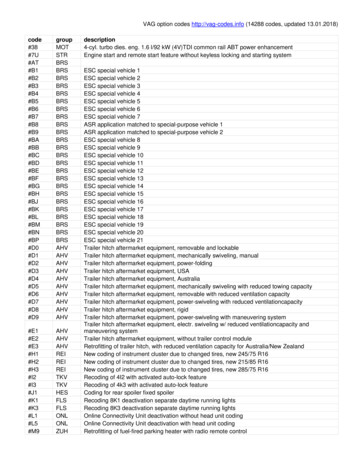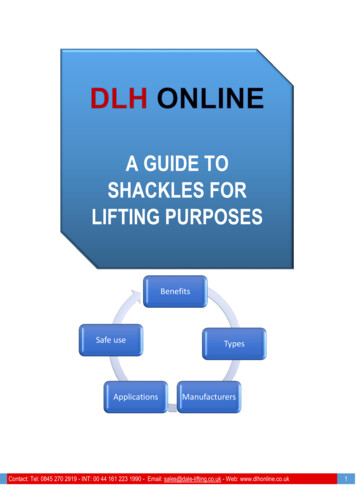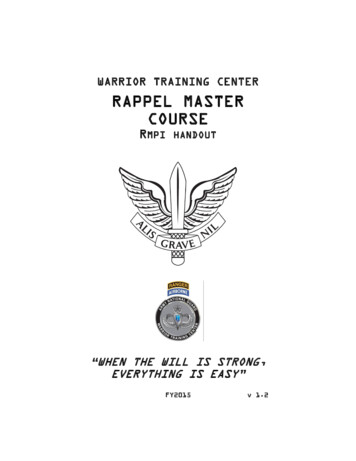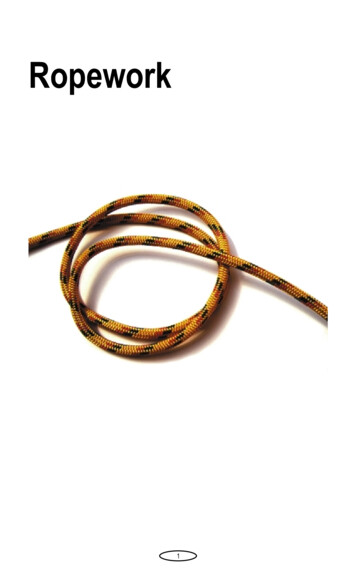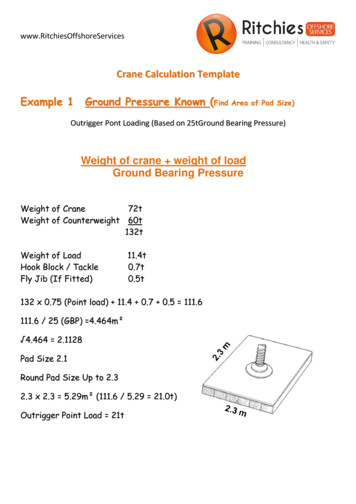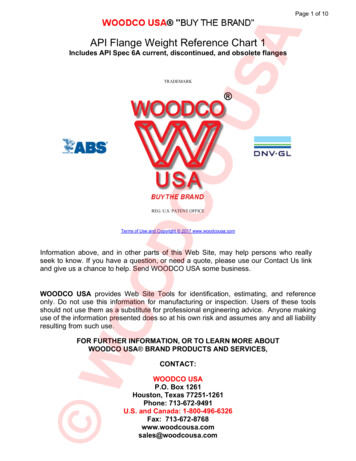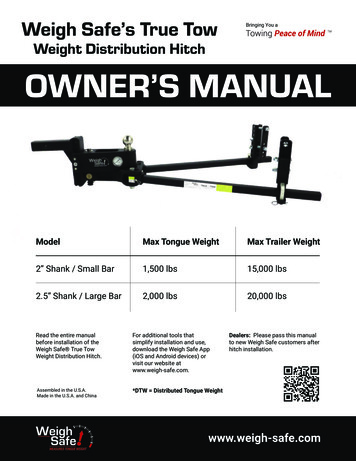
Transcription
Weigh Safe’s True TowBringing You aWeight Distribution HitchOWNER’S MANUALModelMax Tongue WeightMax Trailer Weight2” Shank / Small Bar1,500 lbs15,000 lbs2.5” Shank / Large Bar2,000 lbs20,000 lbsRead the entire manualbefore installation of theWeigh Safe True TowWeight Distribution Hitch.For additional tools thatsimplify installation and use,download the Weigh Safe App(iOS and Android devices) orvisit our website atwww.weigh-safe.com.Assembled in the U.S.A.Made in the U.S.A. and China*DTW Distributed Tongue WeightDealers: Please pass this manualto new Weigh Safe customers afterhitch installation.
TABLE OF CONTENTSIMPORTANT SAFETY INFORMATION. 3PARTS BREAKDOWN. 4STEP 1 - PRE-SETUP . 6STEP 2 - TOW BALL INSTALLATION . 6STEP 3 – HEAD ASSEMBLY HEIGHT ADJUSTMENT . 7STEP 4 - TRAILER BRACKET INSTALLATION . 8TRAILER BRACKET LOCATION . 8INSTALLATION OF TRAILER BRACKETS ONTO FRAME . 9SETTING HEIGHT OF SPRING ARM PLATFORM . 9STEP 5 - SPRING ARM ASSEMBLY . 10STEP 6 - DISTRIBUTED TONGUE WEIGHT (DTW) . 11STEP 7 - CONNECTING SPRING ARMS . 12STEP 8 - LIVE WEIGHT DISTRIBUTING SYSTEM . 13STEP 9 - DISCONNECTING YOUR HITCH . 14STEP 10 - REGULAR INSPECTION AND MAINTENANCE . 15LIMITED WARRANTY . 16Required Tools DTW calculator on the Weigh Safe App or at www.weigh-safe.com (Required to properly adjust the hitch) Measuring tape Lift bracket with ¾” socket end (provided). ***¾” socket with socket wrench or ¾” star wrench recommendedbut not required. Torque wrench capable of 65 ft-lb ¼” hex wrench (provided)Attention Weigh Safe Hitch OwnerKeep This ManualPlease keep this manual available for reference in the event you do not have access to the Weigh Safe App orto our website at www.weigh-safe.com.Replacement:This manual is available on the Weigh Safe App and on our website at www.weigh-safe.com. You can alsorequest a replacement copy by calling Weigh Safe Customer Support at (801) 820-7020.Further Assistance:For help installing or using your Weigh Safe True Tow Weight Distribution Hitch, please contact a qualifiedWeigh Safe Dealer in your area, call Weigh Safe Customer Support at (801) 820-7020, or email us atsupport@weigh-safe.com.2www.weigh-safe.com
IMPORTANT SAFETY INFORMATIONFAILURE TO FOLLOW ALL SAFETY WARNINGS MAYRESULT IN SEVERE INJURY OR DEATHmeets or exceeds the Gross Vehicle Weight (GVW)requirements for your specific trailer. WARNINGALWAYS use a tow ball size that matches yourtrailer’s coupler size and double check to make surethe tow ball and the trailer coupler are properly andsecurely joined prior to towing.The Weigh Safe True Tow Weight Distribution Hitchis for personal, non-commercial use only.Installing, setting up, and measuring weightdistribution appropriately does NOT guaranteesafe towing. The vehicle operator is responsible tooptimize weight distribution and sway control bymaking necessary adjustments. However, each tripand load are different. The weight distribution setupand towing performance should be evaluated by thevehicle operator and adjusted appropriately bothbefore and during the tow.ALWAYS inspect all fasteners prior to each trip forwear/tear and fatigue. Ensure all nuts, bolts, pins, andclips are tightly and securely in place. Do NOT towyour trailer until all fasteners have been checked.Responsibility falls on the driver to properly adjustthe towing equipment and to adjust his or her drivinghabits to account for the trailer requirements, thetowing conditions, and the road conditions. Thedriver alone is responsible for their own safety andthe safety of any passengers in the vehicle. Towingwith a tongue weight of less than 10% or more than15% of the gross trailer weight greatly increases thelikelihood for loss of vehicle control.NEVER cut, weld, grind, bend, or modify any of thehitch components in any way.Thoroughly read, understand, and follow all safetywarnings, setup, use, and maintenance instructionsof your tow vehicle, trailer, and towing/hitchingequipment prior to installing your hitch and beforetowing your trailer.Even if a dealer installed your hitch, verify that thehitch is properly adjusted after loading your traileronto the tow vehicle prior to your trip.This hitch setup does not guarantee that trailer swaywill be avoided altogether.ALWAYS load the contents of a trailer correctlyand properly. Follow tow vehicle and the trailermanufacturer’s recommendations for quantity andplacement of cargo.ALWAYS use a tow ball with a weight rating thatNEVER tow until your hitch is properly adjusted.NEVER exceed the weight rating specified for thetow vehicle, trailer, hitch, tow ball, or any other towingequipment.NEVER tow with your spring arms attached in extremeroad conditions including, but not limited to, on roughroads, through ditches or dips, or while launching aboat. Excessive strain on the spring arms and hitchhead may cause hitch fatigue and/or failure.NEVER transfer your hitch to a different tow vehicleor trailer without re-adjusting the hitch for propersetup and weight distribution required by the new towvehicle. CAUTIONDo NOT loosen or remove any part of the hitch whilethe hitch is in use with a trailer hooked up. Use thetrailer tongue jack to remove the tension from theSpring Arms prior to removing the L-Fingers.ALWAYS secure the tow vehicle and trailer by applyingthe parking brake and wheel stops prior to setup oradjustments.To avoid excessive strain on the hitch assembly,disengage spring arms prior to towing or backing upthe trailer across a significant transition in grade (e.g.,backing from a flat street to a steep uphill driveway).*DTW Distributed Tongue Weight3
PARTS BREAKDOWN*DTW Distributed Tongue Weight4
PARTS BREAKDOWNItem #Part Number*Part DescriptionQty Per Hitch1WDDB6-2WDDB6-2.5WDDB8-2WDDB8-2.5Draw Bar 6” Drop w/ 2” ShankDraw Bar 6” Drop w/ 2.5” ShankDraw Bar 8” Drop w/ 2” ShankDraw Bar 8” Drop w/ 2.5” Shank12WSB-LWSB-XLWSB-XXL15WSB-XXL201- 7/8” Tow Ball 7,500 lbs.2” Tow Ball 8,000 lbs.2-5/16” Tow Ball for 2” Shank 15,000 lbs.2-5/16” Tow Ball for 2.5” Shank 20,000 lbs.13WD231/2” Ball Pin Lock Washer14WDBSM1WDBLG1Spring Arm for 2” ShankSpring Arm for 2.5” Shank2 of the same size5WDLALift Arm16WS08Dust Lock Cover17SWS03Steel Lock Plate Key Assembly (Dual Pins)18WS09Keys (Please Indicate Key Code for Replacement)19WDSL2WDSL2.5Weight Distribution Head Assembly for 2” ShankWeight Distribution Head Assembly for 2.5” Shank110WD19Clevis Pin with Cotter Pin211WD21Grade 8 Bolt212WD04½” Shoulder Ball Pin113WD20¼” Hex Wrench114WD17½” Nut (Grade 5)815WD18½” Lock Washer816WD02Inside Flat Bracket217WD13½” x 3” Carriage Bolt (Grade 5)418WD05Outside C Channel Bracket219WD07Spring Arm Platform220WD11L-Finger Pin221WD09L-Finger222WD15½” x 3-1/2” Carriage Bolt (Grade 5)45www.weigh-safe.com
INSTALLATIONStep 1 - Pre-SetupPark your trailer and tow vehicle on flat level ground in line with each other. Put wheel stops on trailer wheelsand uncouple trailer from the tow vehicle. Pull the tow vehicle forward 4 to 5 feet to allow for working space.With the Weigh Safe True Tow Weight Distribution Hitch, setup is dependent on the measured tongue weightfor each separate tow. Be sure to measure your tongue weight without Spring Arm attachment prior to eachconnection and adjust your hitch according to the instructions below. Tongue weight will change with thevarying levels of the propane and freshwater tanks, and any other cargo the trailer will carry, including toys fortoy haulers.Check and inflate all tires of the system to the proper pressure before every trailer and tow vehicle connection.Step 2 - Tow Ball InstallationInsert the correctly sized Weigh Safe Tow Ball into the designated hole of the hitch Head Assembly.See Figure 1.Figure 2Figure 1Once the ball is resting at the bottom, use the provided ½” Shoulder Ball Pin and ½” Lock Washer and tightenwith ¼” Hex Wrench until bolt is completely tight and is subflush with the face of the Head Assembly. SeeFigure 2. Torque to 30 ft-lb.6www.weigh-safe.com
INSTALLATIONStep 3 – Head Assembly Height AdjustmentNotice: If you don’t know your actual tongue weight, quickly measure your tongue weight by putting on the headassembly at a best guess height and lower your trailer onto the tow ball completely. The gauge will show yourtongue weight. Continue with instructions to set head height correctly.Figure 3Level the trailer to be parallel to the ground. This can be done by measuring the front and back of the trailerframe to the ground. Adjust where needed so both the front and back measurements are the same.With the trailer level, measure from the ground to the top of the trailer coupler. The top of the Tow Ball on theHead Assembly should be some distance above this measurement. The distance will depend on what thetongue weight of the trailer is and what kind of suspension is on the tow vehicle. A good rule of thumb is to setthe Tow Ball ⅛” higher for every 100 lbs. of tongue weight. See Figure 3.Figure 4*DTW Distributed Tongue Weight7
INSTALLATIONInsert the correct size of Draw Bar into the receiver of the tow vehicle. Depending on what the height of thetrailer coupler is, the Draw Bar may need to be in the rise or drop position. See Figure 4.Slide the Head Assembly onto the Draw Bar and insert the Steel Lock Plate Key Assembly (Dual Pins) into thecorrect holes to set the ball height. Be sure to push the Lock Plate all the way until the pins are fully insertedand the lock tab is engaged. To check this, try and pull out on the Lock Plate making sure the lock tab issecured before towing. See Figure 5 and Figure 6. Secure Dust Lock Cover over the Lock Plate to prevent debrisfrom getting inside the lock.Figure 6Figure 5For future reference, save your height setup into the DTW tool on the Weigh Safe App by inputting both yourDraw Bar position (rise or drop) and how many empty holes are visible above the top of the Head Assembly onthe Draw Bar. Or, if you are using the website, save your height setup here:Rise / Drop (circle one)Empty holes visible:Step 4 - Trailer Bracket InstallationTrailer Bracket LocationLocate the center-line of where the trailer brackets need to be placed bymeasuring from the center of the trailer coupler along the trailer frame andput a mark at 32” on both sides. Ensure there are no brake lines, electricalwiring, or gas lines that would be in the way of the trailer brackets. Ifsomething is obstructing the placement of the trailer brackets, it will needto be re-routed or avoided to prevent damage by the trailer brackets.Securing the trailer brackets at the 32” mark will put the least amount ofstress on the trailer and hitch, providing the safest tow.There are some scenarios where there may be a frame member, propanemount, or battery mount in the way that cannot be moved. In these rarecases, the trailer brackets can be moved forward, closer to the trailercoupler to a minimum distance of 27” from the coupler center. See Figure 7.8www.weigh-safe.comFigure 7
INSTALLATIONInstallation of Trailer Brackets onto FramePlace one of the ½” x 3-½” Carriage Bolts through thetop hole in the Outside C Channel Bracket and align itwith the top hole of the Inside Flat Bracket. Slide onthe ½” Lock Washer and then thread on the ½” Nut acouple of turns. See Figure 8.Slip the brackets over the trailer frame and line up thetop bolt with the center mark line from the previousstep. Tighten the nut until hand tight.Insert the second ½” x 3-½” Carriage Bolt in thehighest open hole in the Outside C Channel Bracketunder the trailer frame and press it through thecorresponding hole on the Inside Flat Bracket. Slideon the ½” Lock Washer and thread on the ½” Nut untilhand tight. See Figure 9.Figure 8There should not be a gap between the top andbottom Carriage Bolts and the trailer frame. If there isa gap larger than ½” it can cause damage to the trailerbrackets.Use ¾” socket end of Lift Arm or ¾” socket wrenchand tighten the ½” nuts. Be sure to alternate betweenthe top and bottom nuts to avoid over tighteningone and not being able to tighten the other onecompletely. Over tightening one can cause damage tothe brackets.Figure 9Setting Height of Spring Arm Platform.Slide the Spring Arm Platform between the OutsideC Channel Bracket and set it to the correct height.The ideal height for the flat portion of the platformis as close to 9” below the top of the trailer coupler.See Figure 10. This will allow the Spring Arms to behorizontal with the trailer frame which will create thesmoothest and safest tow. In rare cases, if the leadscrew on the Head Assembly bottoms out before youreach your DTW*, the Spring Arm Platform might needto be less than 9”.Once you have the Spring Arm Platform set to thecorrect height, insert two ½” x 3” Carriage Bolts intothe square holes in the Outside C Channel Bracket*DTW Distributed Tongue WeightFigure 109
INSTALLATIONthat lines up with the corresponding holes in the Spring Arm Platform. Pressthem all the way in and slide on a ½” Lock Washer and thread on the ½” Nuton each bolt. See Figure 11. Tighten to hand tight. Then use the ¾” socketend of the Lift Arm or ¾” socket wrench and tighten the ½” nuts. All trailerbracket bolts will need to be torqued to 65 ft-lb.Repeat these steps on the other side of the trailer frame for the other trailerbracket.Step 5 - Spring Arm Assembly WARNINGUSING A TORQUE WRENCH, CONFIRM THAT THE SPRING ARM SOCKETBOLTS ARE TORQUED TO A MINIMUM OF 150 FT-LB TORQUE BEFOREEACH TOWING SESSION.Figure 11Notice: The Spring Arm Sockets are being compressed by Socket Bolts in the Head Assembly and are hard totwist. This is to help with sway control. Do not pound directly on the Spring Arm Sockets. This could causethem to chip or crack. Use the Spring Arms as a lever to move the compressed Spring Arm Sockets.Insert the Spring Arms into the Spring Arm Sockets so the hole in the Spring Arm lines up with the hole on theSpring Arm Socket.Insert the Clevis Pin into the hole from the inside to the outside of the hitch. This is to allow easy access forthe Cotter Pin. Secure the Clevis Pin with the Cotter Pin. Repeat these steps on the other side. See Figure 12and Figure 13.Figure 1210Figure 13www.weigh-safe.com
INSTALLATIONStep 6 - Distributed TongueWeight (DTW)Notice: For the following steps, it is required thatyou use the DTW tool found on the Weigh Safe Appor on www.weigh-safe.com. The Weigh Safe TrueTow Weight Distribution Hitch not only provides youwith the ability to measure tongue weight, it will alsoaccurately calculate how much the Spring Arms needto be loaded in order to provide a truly distributedtowing system. This load is reflected in an addedamount of weight to the Weigh Safe gauge. Thatweight is called the Distributed Tongue Weight.Without the DTW tool you will not be able to accuratelycalculate the correct DTW* to set up your systemappropriately.Figure 14Use the following information to setup and adjustyour Weigh Safe True Tow Weight Distribution Hitch.Input your Gross Trailer Weight (GTW) into the DTWtool. Gross Trailer Weight is the overall loaded weightof the trailer. Back up the tow vehicle to the trailerand lower the trailer coupler onto the Tow Ball. Lockthe coupler and insert safety pin/lock for a secureattachment. Continue retracting the trailer tongue jackuntil it raises off the ground. Look at your Weigh Safegauge and input your tongue weight into the DTWtool. Make sure your tongue weight is within a 10-15%range of your GTW.Figure 15Measurement:Once you have your tongue weight inputted, you willneed to take three measurements of your towingsystem to get the correct DTW*. To take dimensions,pull out one of the Spring Arms until the bar isperpendicular to the Head Assembly. This arm will beused as a base point to take measurements. Alwaysmeasure using the side of the Spring Arm closest tothe tow vehicle as the inside face is in line with theTow Ball. Insert the following three measurementsinto the DTW tool or if you are using the website, saveyour measurements on the provided lines.In inches, measure in a straight line from the rearvehicle axle center-line to the Tow Ball. See Figure 15.*DTW Distributed Tongue WeightFigure 16Measurement:11
Figure 17INSTALLATIONMeasurement:In inches, measure in a straight line from the Tow Ball to the center of the trailer brackets. See Figure 16.In inches, measure in a straight line from the Tow Ball to the center-line of a single axle or center-line betweenmultiple axles. See Figure 17.Step 7 - Connecting Spring ArmsNow that you know your DTW*, it is time to hook up the Spring Arms.There are two methods to connect the Spring Arms to the Spring Arm Platforms. The first method is for theinitial setup (out of the box). The second method is ideal for every other connection.Figure 18First Method:Out of the box, the Live Adjustment System in the Head Assembly will be bottomed out leaving the Spring Armsin the highest position. See Figure 18. With the trailer still coupled to the tow vehicle measuring tongue weight,you should be able to slide the Spring Arms onto the Spring Arm Platforms. If you are towing a heavy trailer thatcreates vehicle squat keeping you from being able to slide the Spring Arms onto the Spring Arm Platforms, you12www.weigh-safe.com
INSTALLATIONmay use the trailer tongue jack to lift both tow vehicle and trailer until you can lift the Spring Arms into placeover the Spring Arm Platforms. If that doesn’t work, you may have to use the Lift Arm to lift the Spring Arms uponto the Spring Arm Platforms. See Figure 19.Use the L-Fingers and L-Finger Pins to secure the Spring Arms onto the Spring Arm Platforms. See Figure 20.Figure 20Figure 19Second Method:With the trailer still coupled to the tow vehicle, use the trailer tongue jack to lift both tow vehicle and trailer untilyou can swing the Spring Arms into place over the Spring Arm Platforms. If you reach the highest level or loadof the trailer tongue jack and the Spring Arms are unable to be lifted onto the Spring Arm Platforms, you canuse the Lift Arm to lift the Spring Arms up onto the Spring Arm Platforms. See Figure 19.Use the L-Fingers and L-Finger Pins to secure the Spring Arms on the Spring Arm Platforms. See Figure 20.Repeat step for both Spring Arms on each side of the trailer.Step 8 - Live Weight Distributing SystemNow that the Spring Arms are attached to the trailer, it is time to distribute your towing system using thecalculated DTW* populated on the DTW tool. Using the Lift Arm or a ¾” socket or lug wrench, tighten orloosen the lead screw until your Weigh Safe gauge reaches the DTW* number. Turning it clockwise increasesdistributed tongue weight and counterclockwise decreases distributed tongue weight. See Figure 21.Once the Weigh Safe gauge has reached the DTW*, your system is now distributed. It is important to note thatthe DTW* will normally, but not always, read somewhere between 2 to 3 times your tongue weight.Yes, it was that easy.Notice: Sometimes the added force in the Spring Arms can cause extra friction in the Tow Ball resulting in slowor no change in the tongue weight while adjusting the Lead Screw. If you are noticing your system not movingafter a substantial amount of adjusting, try to stand on or kick the tongue of your trailer to loosen up the highfriction.*DTW Distributed Tongue Weight13
INSTALLATIONFigure 21Step 9 - Disconnecting Your HitchPull your trailer into the place you want it parked; most effectively done on a flat surface.Set the parking brake and put stops under the wheels of the trailer.Unhook the electrical cable, chains, and breakaway cable from the tow vehicle.Raise the trailer tongue jack until it starts to raise both the trailer and tow vehicle. Continue to lift until theweight is lifted off the ends of the Spring Arms, allowing you to easily pull off the Spring Arms from the SpringArm Platforms.Remove L-Finger Pins and L-Fingers.Slide Spring Arms away from the trailer frame to clear the trailer brackets when you lower the trailer tonguejack.Lower the trailer tongue jack until the trailer tongue is again resting on the hitch (showing some tongue weight)and you can unhook the trailer coupler latch.Use the trailer tongue jack to lift the trailer off the Tow Ball and pull the tow vehicle away from the trailer.Unhook the Spring Arms from the Head Assembly and remove the Head Assembly from the Draw Bar.Store your True Tow Weight Distribution Hitch in a safe and secure location that is protected from weatherconditions.14www.weigh-safe.com
INSTALLATIONStep 10 - Regular Inspection and Maintenance WARNINGDo not tow your trailering system unless all bolts and nuts have been properly checked and tightened and allpins and brackets are securely installed. Towing with loose bolts or pins for an extended period can causeabnormal stress on the hitch resulting in accident, severe injury, and/or property damage.Check that all bolts and nuts are torqued to the specified amount in Table 1 before every tow.Check all plugs and screws in the Head Assembly to make sure that none have backed out or are leaking anyhydraulic fluid.Torque SpecificationsBall Shoulder Bolt30 ft-lbs.Trailer Bracket Bolts65 ft-lbs.Spring Arm Swivel Bolts150 ft-lbs.Table 1On the Head Assembly, the friction surfaces should be kept clean and well lubricated with high-pressuremultipurpose or bearing grease. The best way to apply the grease is to twist the Spring Arm Socketscompletely to the outside positions and apply grease to the surfaces where the top and bottom of the SpringArm Sockets contact the rest of the Head Assembly. See Figure 22.There are also two grease ports on the Head Assembly that supply grease to the Lead Screw that needs to beserviced at the beginning of each towing season or bi-annually in warmer climates. To service, use a greasegun filled with high-pressure multipurpose or bearing grease and pump into ports. Fill the top and bottom portsgenerously to keep areas well lubricated.See Figure 23.Figure 22*DTW Distributed Tongue WeightFigure 2315
LIMITED WARRANTYSubject to the terms, conditions, and limitations set forth below, Weigh Safe, LLC (the “Manufacturer”) warrants to the initial purchaser (the“Purchaser”) of this Weigh Safe True Tow Weight Distribution Hitch (the “Hitch”) that (a) all parts, other than the Hitch’s gauge (the “Gauge”), will befree from material defects in parts and/or workmanship that impair the intended use of the Hitch for the usable life of the Hitch; (b) the Gauge readingis accurate within fifty pounds (50 lbs.); and (c) the Gauge will be free from material defects in parts and/or workmanship for a period of one (1) yearafter the date of purchase.1.Purchaser is required to register his or her purchase of the Hitchon Manufacturer’s website (www.weigh-safe.com) within thirty (30) daysof purchase to claim any benefit under this Limited Warranty.2.This Limited Warranty is expressly limited to the repair orreplacement of a defective Hitch, including any part thereof, covered underthis Limited Warranty. In no event will this Limited Warranty extend beyondthe date this product ceases to be manufactured.3.This Limited Warranty is not transferable from the originalpurchaser to subsequent owners, and the warranty period will not beextended in duration or expanded in coverage for any such transfer.4.To make a Limited Warranty claim, Purchaser must contactManufacturer at 420 North Geneva Road, Lindon, Utah 84042, to determineany specific needs and/or to obtain a Return Merchandise Authorizationnumber.5.Manufacturer reserves the right to examine any and all physicalevidence that a Hitch may be defective as Purchaser claims including, butnot limited to, the Hitch itself, any photographs, etc., and to recover theHitch, prior to approving any claim under this Limited Warranty.6.Unless indicated otherwise by Manufacturer, the Hitch mustbe shipped, at Purchaser’s expense, to Manufacturer—with a copy of therelevant proof of purchase—so Manufacturer can evaluate whether a claimis covered under this Limited Warranty. Manufacturer will not be liable foror at risk of any damage or loss occurring while the Hitch or any part thereofis in transit to Manufacturer for evaluation under this Limited Warranty.Upon receipt, Manufacturer will examine the Hitch and determine, in itssole and absolute discretion, whether (a) this Limited Warranty applies tothe Hitch, its state, and its condition; and (b) the Hitch will be repaired orreplaced. Any and all dealer service charges, labor costs, shipping costs,insurance, travel expenses and any other charges or expenses involvedin the installation, removal, or replacement of the Hitch including, but notlimited to, any part thereof covered under this Limited Warranty will bethe sole and exclusive responsibility of the Purchaser. Manufacturer willrefuse any Hitch or any part thereof shipped C.O.D.7.THIS LIMITED WARRANTY IS VOID IF THE HITCH HAS BEENDAMAGED BY ACCIDENT, USE OTHER THAN THE HITCH’S INTENDED USE,UNREASONABLE USE, AND/OR ANY ABUSE, NEGLIGENCE, IMPROPERSERVICE OR REPAIR, IMPROPER INSTALLATION OR HANDLING, FAILURETO FOLLOW PROVIDED INSTRUCTIONS, SHIPPING, VANDALISM, ACTS OFGOD, ENVIRONMENTAL FACTORS, ALTERATION OF THE HITCH, OR ANYOTHER EVENT BEYOND MANUFACTURER’S CONTROL , OR OTHER CAUSESNOT ARISING OUT OF DEFECTS IN MATERIALS OR WORKMANSHIP.8.THIS HITCH IS FOR PERSONAL, NON-COMMERCIAL USE ONLY.USING THE HITCH FOR OTHER THAN PERSONAL USE, AS A VEHICLETOWING HITCH, OR USE IN ANY MANNER INCONSISTENT WITH ITSINTENDED USE OR PURPOSE, WILL IMMEDIATELY AND AUTOMATICALLYVOID THIS LIMITED WARRANTY.9.THIS LIMITED WARRANTY DOES NOT COVER ANY LIABILITY TOPERSON OR PROPERTY THAT MAY OCCUR UPON: (i) Purchaser’s failureto correctly and/or securely attach the Hitch or a tow load; (ii) Purchaser’sfailure to accurately interpret the Gauge or to use the Hitch within thegross trailer weight range, tongue weight range, and tow-ball weight ratingspecified for the applicable towing vehicle, trailer, tow, tow ball, boat, etc.16including upon initially attaching a tow load and after adding any additionalload(s); (iii) Purchaser’s failure to properly secure any load to avoid shiftingof objects or weight; or (iv) Purchaser’s failure to comply with trafficregulations or to drive safely or reasonably. The failure of Purchaser in anysimilar circumstance to those described in this Section 9 will immediatelyand automatically void this Limited Warranty.10.Manufacturer does not warrant the Hitch will prevent any trafficaccident, or be free from damage in the event of a traffic accident or otherincident arising from an act of God.11.THIS LIMITED WARRANTY DOES NOT COVER SCUFFS ORSCRATCHES THAT CAN RESULT FROM NORMAL OR EXPECTED USE OFTHE HITCH. THIS LIMITED WARRANTY ALSO DOES NOT COVER RUSTINGPARTS, CRACKS THAT DO NOT AFFECT THE FUNCTIONALITY OF THEHITCH, OR OTHER DAMAGE CAUSED BY WEATHER, CLIMATE CONDITIONS,OR EXPOSURE TO CORROSIVES SUCH AS SALTS, PESTICIDES, ETC.12.THIS EXPRESS LIMITED WARRANTY IS GIVEN IN LIEU OF ALLOTHER WARRANTIES AND IS THE SOLE AND EXCLUSIVE WARRANTY FORTHE HITCH. MANUFACTURER DISCLAIMS ANY AND ALL OTHER ORALOR WRITTEN REPRESENTATIONS, EXPRESS OR IMPLIED, FROM ANYSOURCE CONCERNING THE HITCH. ANY IMPLIED WARRANTY ARISINGOUT OF THE SALE OF THE HITCH, INCLUDING, BUT NOT LIMITED TO,THE IMPLIED WARRANTIES OF MERCHANTIBILITY AND FITNESS FOR APARTICULAR PURPOSE, IS LIMITED IN DURATION TO THE DURATION OFTHIS LIMITED WARRANTY. Some states do not allow limitations on howlong an implied warranty lasts, so the above limitation may not apply tocertain purchasers.13.THE REPAIR OR REPLACE REMEDY STATED ABOVE SHALLBE PURCHASER’S EXCLUSIVE REMEDY. MAN’UFACTURER DOES NOTASSUME, OR AUTHORIZE ANY PERSON OR REPRESENTATIVE TOASSUME ON ITS BEHALF, ANY OTHER LIABILITY IN CONNECTION WITHANY SALE OF THE HITCH. MANUFACTURER SHALL NOT BE LIABLEFOR (A) ANY DAMAGES OR EXPENSES THAT MAY OCCUR INCLUDING,BUT NOT LIMITED TO, INCIDENTAL, SPECIAL, OR CONSEQUENTIALDAMAGE
Please keep this manual available for reference in the event you do not have access to the Weigh Safe App or to our website at www.weigh-safe.com. Replacement: This manual is available on the Weigh Safe App and on our website at www.weigh-safe.com. You can also request a replacement copy by calling
